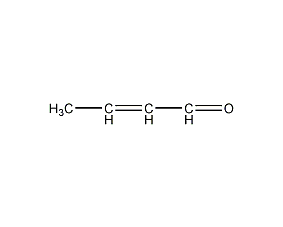
Structural formula
| Business number | 03H1 |
|---|---|
| Molecular formula | C4H6O |
| Molecular weight | 70.09 |
| label |
2-Butenal, (E)-2-Butenal, Trans-butenal, Crotonaldehyde, (E)-Butenal, trans-butene-2-aldehyde, foaming agent, antioxidants, pesticides |
Numbering system
CAS number:123-73-9
MDL number:MFCD00007003
EINECS number:204-647-1
RTECS number:GP9625000
BRN number:None
PubChem number:24855882
Physical property data
1. Properties: colorless, transparent and flammable liquid
2. Relative density (25/4℃): 0.8495
3. Refractive index: 1.4384
4. Flash point (℃): 13
5. Melting point (℃): -69
6. Boiling point (ºC): 102.2
Toxicological data
Mouse LC501.51mg/L. Wear masks, gloves and other protective equipment during operation. The maximum allowable concentration in the air is 0.5mg/m3.
Ecological data
None yet
Molecular structure data
5. Molecular property data:
1. Molar refractive index: 20.82
2. Molar volume (cm3/mol): 85.4
3. Isotonic specific volume (90.2K): 187.3
4. Surface tension (dyne/cm): 23.0
5. Polarizability (10-24cm3): 8.25
Compute chemical data
1. Hydrophobic parameter calculation reference value (XlogP): 0.5
2. Number of hydrogen bond donors: 0
3. Number of hydrogen bond acceptors: 1
4. Number of rotatable chemical bonds: 1
5. Number of tautomers:
6. Topological molecular polar surface area (TPSA): 17.1
7. Number of heavy atoms: 5
8. Surface charge: 0
9. Complexity: 45.6
10. Number of isotope atoms: 0
11. Determine the number of atomic stereocenters: 0
12. Uncertain number of atomic stereocenters: 0
13. Determine the number of chemical bond stereocenters Number: 1
14. Number of uncertain chemical bond stereocenters: 0
15. Number of covalent bond units: 1
Properties and stability
1. There are two isomers, cis and trans. The cis-heterosome is unstable. Popular�The product is the trans isomer. Colorless, transparent and flammable liquid with a suffocating odor. When in contact with light or air, it turns into a light yellow liquid and gradually oxidizes into crotonic acid. Its vapor is toxic to the eyes and respiratory tract and is a strong tear-trigger. Melting point -69°C, boiling point 102.2°C, relative density 0.8495 (25/4°C), relative vapor density 2.41 (air = 1), refractive index 1.4384. Flash point (open cup) 13℃. It can be mixed with ethanol, ether, benzene, toluene, kerosene and gasoline in any proportion, and is easily soluble in water. Solubility in water (% by weight): 20℃ is 15.5℃; 5℃ is 16.1. The azeotropic point with water is 84°C, and contains 75.7% (weight) crotonaldehyde. Pure crotonaldehyde is easy to resinize and can be slowly oxidized into crotonic acid
2.It will cause burning pain when in contact with the skin. Long-term inhalation can cause memory loss and damage mucosal tissue. Mouse LC501.51mg/L. Wear masks, gloves and other protective equipment during operation. The maximum allowable concentration in the air is 0.5mg/m3.
Storage method
It is packed in iron drums, but water-saturated crotonaldehyde should be packed in aluminum, stainless steel drums or phenolic resin lined drums. Contact with heat sources or open flames should be avoided, and storage containers should be tightly closed. Store and transport according to regulations for flammable and toxic chemicals.
Synthesis method
It is produced by the liquid-phase condensation of acetaldehyde under the catalysis of alkali or anion exchange resin to form butyraldehyde, which is then heated, condensed and dehydrated in dilute acid. Each ton of crotonaldehyde consumes 1405kg of acetaldehyde; 4.7kg of sodium hydroxide; and 4kg of aldehyde.
![]()
Purpose
Organic synthesis raw materials, used to produce butyraldehyde; butanol; 2-ethylhexanol; sorbic acid; 3-methoxybutyraldehyde; 3-methoxybutanol; crotonic acid; quinaldine ; Maleic anhydride and pyridine products. In addition, the reaction between crotonaldehyde and butadiene can produce epoxy resin raw materials and epoxy plasticizers. Heat-resistant resin raw materials can be obtained by reacting with pentaerythritol. Crotonaldehyde can also be used to prepare foaming agents for mineral processing; dyes and rubber antioxidants; pesticides and military chemicals. Industrial grade crotonaldehyde is actually a mixture of trans isomers and cis isomers [4170-30-3]. However, the cis isomer is unstable and its content is less than 1%.

 微信扫一扫打赏
微信扫一扫打赏

